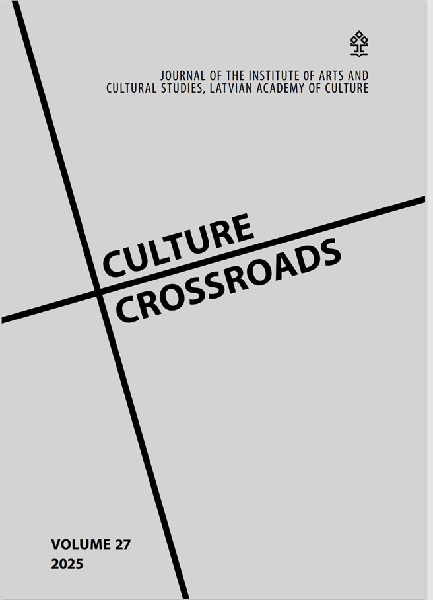CINEMA AUDIENCE HABITS IN TRANSITION: MORE NETFLIX, LESS CINEMA?
DOI:
https://doi.org/10.55877/cc.vol27.538Keywords:
Latvian contemporary cinema, streaming services, cinema audience, audience researchAbstract
The author investigates the evolving habits of Latvian cinema audiences amid increasing digitalization and the growing prominence of streaming platforms. The research addresses key questions about whether streaming services are drawing audiences away from cinemas or complementing the traditional cinematic experience. It aims to examine the interaction between digital and in-person film consumption, with a particular focus on how audience habits have adapted to hybrid viewing models. Using a quantitative survey method, the author analysed data from 650 respondents, gathered through face-to-face interviews in nine cinemas across Latvia. Grounded in theories of cultural consumption and audience mobility, the results indicate a dominant hybrid consumption model among cinema audiences. The findings reveal that heavy cinemagoers also frequently use streaming platforms, which expands their access to diverse genres and film experiences. This suggests that digital platforms serve as a complementary, rather than competing, medium for film audiences. The study concludes that, while digitalization has significantly impacted cinema attendance practices, cinemas retain a unique role by providing immersive, high-quality, and social experiences, particularly for Latvian films. Cinemas with a focus on local content continue to play a culturally significant role. These insights provide a new understanding of cinema audiences in Latvia, underscoring the need for cinemas to adapt to an increasingly hybrid consumption landscape to meet the evolving demands of an active and diverse audience.
Downloads
References
AudienceNet (2020). Digital Culture: Consumption in Lockdown. Insights from the Consumer Tracking Study. Available: https://pec.ac.uk/assets/publications/ The-PEC-and-IPO-cultural-consumption-study-insights-from-the-six-week-study.pdf (viewed 11.09.2024)
Bonel, E., Capestro, C., & Maria, E. (2023). How COVID‐19 impacted cultural consumption: an explorative analysis of Gen Z’s digital museum experiences. Italian Journal of Marketing, pp. 135–160. https://doi.org/10.1007/s43039-023-00071-6
Bourdieu, P. (1986). The Forms of Capital. In: J. Richardson (ed.), Handbook of Theory and Research for the Sociology of Education. New York: Greenwood, pp. 241–258.
Budanceva, J., & Svirina, A. (2023). Consumption of cultural content in the digital environment in the post-pandemic Latvia. Economics and Culture, No. 20 (2).
Capalbi, A., Fabbry, T., & Ierverse, V. (2021). New Digital Cinema: How Platforms Are Changing the Audiovisual Industry. Acta Universitatis Sapientiae, Communicatio, No. 8, pp. 22–35.
Coavoux, S., & Aussant, A. (2024). The Netflix Omnivore. The effect of streaming platforms on cultural diversity and inequalities.
Centrālā statistikas pārvalde (2024). Demogrāfija. Available: https://admin.stat.gov.lv/ system/files/publication/2024-10/Nr_04_Demografija_2024_%2824_00%29_ LV.pdf (viewed 15.01.2025)
Dey, B., Yen, D., & Samuel, L. (2019). Digital consumer culture and digital acculturation. International Journal of Information Management. https://doi.org/10.1016/j. ijinfomgt.2019.102057
European Audiovisual Observatory (2024). Focus 2024 – World film market trends. Fiske, J. (1989). Understanding Popular Culture. London: Unwin Hyman.
Hanchard, M., Merrington, P., & Wessels, B. (2022). The dynamics of audience practices: Mobilities of film consumption. Participations: Journal of Audience and Reception Studies, No. 19 (1).
Hanzlík, J. (2024). Promoting Films in Cinemas and on Streaming Platforms: Cinema Events in Czechia. In: C. Meir & R. Smits (eds.), European Cinema in the Streaming Era. Palgrave European Film and Media Studies, pp. 151–170.
Latvijas Kultūras akadēmija un SIA Pētījumu centrs SKDS (2018). Kultūras patēriņa un līdzdalības ietekmes pētījums. Available: https://www.km.gov.lv/sites/km/files/ lka20zpc_kulturas20paterins20un20lidzdaliba2020181_0.pdf (viewed 11.09.2024)
Latvijas Kultūras akadēmija un SIA Pētījumu centrs SKDS (2022). Kultūras aktivitātes barometrs 2022. Kultūras patēriņa un līdzdalības ietekmes pētījums. Available: https:// www.km.gov.lv/sites/km/files/media_file/kulturas-barometrs_2022_petijums.pdf (viewed 11.09.2024)
Mihelj, S., Leguina, A., & Downey, J. (2019). Culture is digital: Cultural participation, diversity and the digital divide. New Media & Society, No. 21 (7), pp. 1465–1485.
Smits, R. (2024). Theatrical Distribution or Online Streaming? Release Strategies in Europe in Times of Disruption and Change. In: C. Meir & R. Smits (eds.), European Cinema in the Streaming Era. Palgrave European Film and Media Studies, pp. 85–108.
Suny, R. G. (1998). Provisional Stabilities: The Politics of Identities in Post-Soviet Eurasia. The University of Chicago. Available: http://www.dartmouth.edu/~crn/crn_papers/ Suny.pdf (viewed 01.07.2015)
Taillibert, C. (2024). Cinephile Culture on Online Platforms in France: Rethinking the Process of Cultural Mediation. In: C. Meir & R. Smits (eds.), European Cinema in the Streaming Era. Palgrave European Film and Media Studies, pp. 171–188.
UNESCO, Department of Culture and Tourism – Abu Dhabi (2022). Culture in Times of Covid-19. Resilience, Recovery and Revival. Available: https://unesdoc.unesco.org/ ark:/48223/pf0000381524?locale=en (viewed 11.09.2024)
Urry, J. (2008). Mobilities. Cambridge: Polity Press. Vidackovic, Z., Zigo, I. R., & Naglic, F. (2023). Digital Transformation of Cinema in the 21st Century and Its Impact. 104th International Scientific Conference on Economic and Social Development – Rio de Janeiro, 23–25 November, 2023, pp. 97–106.
Vinogradova, L. (2025). Kinoteātru auditorija Latvijā: klātienes un digitālā filmu patēriņa prakses. Pētījuma ziņojums. Available: https://drive.google.com/file/d/1M4Y27_ Xe0_3N6f7cyYWLeba-NGMeNzCA/view (viewed 24.03.2025)
Downloads
Published
Issue
Section
License
Copyright (c) 2025 Culture Crossroads

This work is licensed under a Creative Commons Attribution 4.0 International License.


